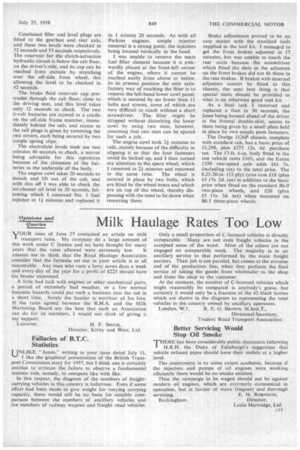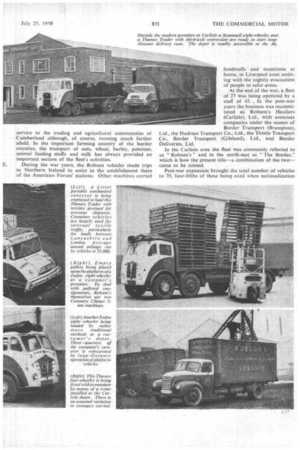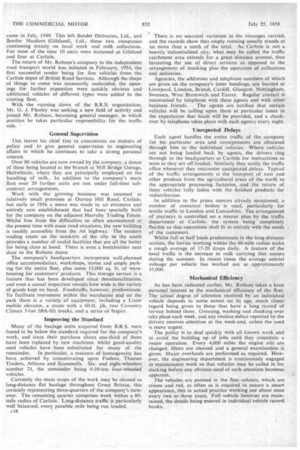Milk Haulage Rates Too Low
Page 55

Page 56

Page 57

Page 58

If you've noticed an error in this article please click here to report it so we can fix it.
TOUR issue of June 27 contained an article on milk transport rates. My company do a large amount of this work under C licence and we have thought for many
years that the rates allowed were extremely low. It amazes me to think that the Road Haulage Association consider that the formula set out in your article is at all reasonable. Any man who runs a lorry seven days a week and every day of the year for a profit of £225 should havehis brains examined.
A little bad luck with engines or other mechanical parts, a period of extremely bad weather, or a few normal business hazards could put such a business into the red in a short time. Surely the haulier is worthier of his hire. If the rates agreed between the R.H.A. and the Milk Marketing Board are the best that such an Association can do for its members, I would not think of giving it my support.
Leicester. H. F. SMITH,
Director, Kirby and West, Ltd.
Fallacies of B.T.C. Statistics
UNLIKE "Janus," writing in your issue dated July 11, like the graphical presentation of the British Transport Commission story for 1957, but I think one is certainly entitled to criticize the failure to observe a fundamental statistic rule, namely, to compare like with like.
In this respect, the diagram of the numbers of freightcarrying vehicles in this country is ludicrous. Even if some effort had been made to give weight for varying carrying capacity, there would still be no basis for sensible comparison between the numbers of ancillary vehicles and • the numbers of railway wagons and freight road vehicles.
Only a small proportion of C-licensed vehicles is directly comparable. Many are not even freight vehicles in the accepted sense of the word. Most of the others are not engaged on comparable work. The majority is in an ancillary service to that performed by the main freight carriers. Their job is not parallel, but comes at the extreme end of the production line, when they perform the final service of taking the goods from wholesaler to the shop and from the shop to the customer.
At the moment, the number of C-licensed vehicles which might reasonably be compared is anybody's guess, but certainly ,it would only be a fraction of the 42 black lorries which are shown in the diagram as representing the total vehicles in the country owned by ancillary operators.
London, W.1. R. E. G. BROWN, M.Inst.T.,
Divisional Secretary, Traders' Road Transport Association.
Better Servicing Would Stop Oil Smoke
'THERE has been considerable public discussion following H.R.H. the Duke of Edinburgh's suggestion that vehicle exhaust pipes should have their outlets at a higher level.
The controversy is to some extent academic, because if the injectors and pumps of oil engines were working efficiently there would be no smoke emitted.
Thus the campaign to be waged should not be against modern oil engines, which are extremely economical in operation, but in favour of more frequent and thorough
servicing. E. FL ROBINSON,
Buckingham. Director, Leslie Hartridge, Ltd.
THE knife of nationalization in its day cut deeply through the haulage industry and, even where the patient has since been restored to something like his former state, scars often remain in the shape of drastic alterations in the form of the business. In the case of Robson's Border Transport, Ltd., of Carlisle, although there have been detail changes, the story is still that of general haulage throughout Great Britain but with a fleet somewhat larger than before nationalization.
Annual mileages of the Robson fleet are currently running up to a total in the region of 34-m., and lately traffic well in excess of 1,000 tons daily has been carried. The success or failure of operations of this calibre must depend in some considerable measure on the spirit existing within an organization. I wanted to know what was the incentive that kept this large fleet working steadily.
Mr. S. Robson had a concise reply: "Payment of good wages to top-class men." A transport organization, he continued, could only be as good as its staff, for they were the fleet's ambassadors. Mr. Robson knows most of the answers in the haulage game, for he started in business in Cumberland in 1925, at the age of 19, using a Model-T Ford which he converted from a private car and drove himself. At the outset, his principal loads were small consignmmts which were distributed over a limited area. Growing success saw the acquisition of a further vehicle only 12 months after the start of the business. As older readers will remember, this was an age when enterprise and industry might overcome the limitations of finance. Always interested in the mechanical side, Mr. Robson actually constructed certain of the early vehicles himself, sometimes employing used power units and chassis. On occasion he gave assistance to a blacksmith acquaintance in exchange for the use of the smithy for the purpose of forging the necessary metalwork.
Even as the business opened out, the radius covered was limited and any type of traffic that was offered was carried, some periods during the early days being largely devoted to the somewhat unrewarding task of county council haulage. As the work grew, there were times when Mr. Robson would return from a day's deliveries, lay sacks on the kitchen floor at his home, remove the engine and proceed to fit new piston rings, or carry out other repairs, preparatory to leaving again at 6 a.m.
The business continued to expand quietly but Mr. Robson regards 1936, when he purchased his first Foden, as the turning point. A six-wheeled twin-steering 10-tonner, this was named "Border Queen," and thereafter every new vehicle was given a title. As each driver has his own unit the use of such names becomes an additional source of pride.
Up to this time the business had been an individual concern, but in 1936 a company was incorporated as Robsons (Hauliers), Ltd. The fleet continued to give special service to the trading and agricultural communities of Cumberland although, of course, running much farther afield. In the important farming country of the border counties, the transport of oats, wheat, barley, potatoes, animal feeding stuffs and milk has always provided an important section of the fleet's activities.
E. During the war years, the Robson vehicles made trips to Northern Ireland to assist in the establishment there of the American Forces' stations. Other machines carried , foodstuffs and munitions at home, in Liverpool even assisting with the nightly evacuation of people to safer areas.
At the end of the war, a fleet of 27 was being operated by a staff of 45. In the post-war years the business was reconstituted as Robson's Hauliers (Carlisle), Ltd., with associate companies under the names of Border Transport (Brampton), Ltd., the Hadrian Transport Co., Ltd., the Thistle Transport Co., Border Transport (Gilsland), Ltd., and Border Deliveries, Ltd.
In the Carlisle area the fleet was commonly referred to as " Robson's " and in the north-east as "The Border," which is how the present title—a combination of the two— came to be coined, Post-war expansion brought the total number of vehicles to 70, four-fifths of these being axed when nationalization came in July, 1949. This left Border Deliveries, Ltd., and Border Hauliers (Gilisland), Ltd., these two companies continuing mainly on local work and milk collections. For most of the time 10 units were stationed at Gilsland and four at Carlisle.
The return of Mr. Robson's company to the independent road transport world was initiated in February, 1954, the first successful tender being for five vehicles from the Carlisle depot of British Road Services. Although the shape of things to come was necessarily undecided, the openings for further expansion were quickly obvious and additional vehicles of different types were added to the existing fleet;
With the running down of the B.R.S. organization, Mr. G. J. Flenley was seeking a new field of activity and joined Mr. Robson, becoming general manager, in which position he takes particular responsibility for the traffic side.
General Supervision
This leaves his chief free to concentrate on matters of policy and to give general supervision to engineering affairs in which he continues to take a strong personal interest.
Over 80 Vehicles are now owned by the company, a dozen of these being located at the branch at Mill Bridge Garage, Haltwhistle, where they are principally employed on the handling of milk. In addition to the company's main , fleet over 20 further units are run under full-time subcontract arrangements.
Work with the growing business was resumed at relatively small premises at Durran Hill Road, Carlisle, but early in 1956 a move was made to an extensive and entirely new establishment that had been specially built for the company on the adjacent Harraby Trading Estate. Whilst free from the difficulties so often encountered at the present time with main road situations, the new building is readily accessible from the A6 highway. The modern trading estate on the outskirts of the city to the south provides a number of useful facilities that are all the better for being close at band. There is even a bodybuilder next door to the Robson depot.
The company's headquarters incorporate well-planned office accommodation, workshops, stores and ample parking for the entire fleet, plus some 15,000 sq. ft. of warehousing for customers' products. This storage service is a feature that has been developed since denationalization, and even a casual inspection reveals how wide is the variety of goods kept on hand. Foodstuffs, however, predominate. To facilitate movement within the warehouse and on the park there is a variety of equipment, including a Lister mobile elevator, a crane with a 60-ft. jib, two Coventry Climax 3-ton felrk-lift trucks, and a series of bogies.
Improving the Standard
Many of the haulage units acquired from B.R.S. were found to be below the standard required for the company's work, and since their purchase about one-third of them have been replaced by new machines, whilst good-quality used vehicles have been substituted for many of the remainder. In particular, a measure of homogeneity has been achieved by concentrating upon Fodens, Thames Traders, Albions and Scammells. Sixand eight-wheelers number 21, the remainder being 6-10-ton four-wheeled vehicles.
Currently the main scope of the work may be classed as long-distance flat haulage throughout Great Britain, this certainly representing three-quarters of the company's turnover. The remaining quarter comprises work within a 60mile radius of Carlisle. Long-distance traffic is particularly well balanced, every possible mile being run loaded.
c18 There is no seasonal variation in the tonnages carried, and the records show that empty running usually stands at no more than a tenth of the total. As Carlisle is not a heavily industrialized city, what may be called the traffic catchment area extends for a great distance around, thus favouring the use of direct services as opposed to the arrangement of trunking plus the operation of collections and deliveries.
Agencies, the addresses and telephone numbers of which are given on the company's letter headings, are located at Liverpool, London, Bristol, Cardiff, Glasgow, Nottingham, Swansea, West Bromwich and Exeter. Regular contact is maintained by telephone with these agents and with other business friends. . The agents are notified that certain vehicles will be calling upon them at particular times in the expectation that loads will be provided, and a cheekover by telephone takes place with each agency every night.
Unexpected Delays
Each agent handles the entire traffic of the company for his particular area and consignments are allocated through him to the individual vehicles. Where vehicles are not being loaded back by agents, the drivers ring through to the headquarters at Carlisle for instructions as soon as they are off-loaded. Similarly they notify the traffic office whenever they encounter unexpected delays. Typical of the traffic arrangements is the transport of oats and other produce from the agricultural areas of the north to the appropriate processing factories, and the return of these vehicles fully laden with the finished products for redistribu Lion.
In addition to the prime movers already mentioned, a number of container bodies is used, particularly for textile traffic to London and Lancashire. The arrangement of journeys is controlled on a master plan by the traffic department at Carlisle, the system being completely flexible so that operations shall fit in entirely with the needs • of the customers.
Whilst full or half loads predominate in the long-distance section, the lorries working within the 60-mile radius make a rough average of 15-20 drops daily. A feature of the local traffic is the increase in milk carrying that occurs during the summer. In recent times the average annual mileage per vehicle has worked out at approximately 35,000.
Mechanical Efficiency
As has been indicated earlier, Mr. Robson takes a keen personal interest in the mechanical efficiency of the fleet. The actual degree of attention received by an individual vehicle depends to some extent on its age, much closer regard being given to those that have a long record of service behind them. Greasing, washing and checking over take place each week, and any routine defect reported by the drivers receives attention at the week-end, unless the need is more urgent.
The policy is to deal quickly with all known work and to avoid the building up of jobs until they constitute a major operation. Every 4,000 miles the engine oils are changed, filters are cleaned and a general examination is given. Major overhauls are performed as required. However, the engineering department is continuously engaged in maintenance work so that vehicles may be called in for docking before any obvious need of such attention becomes apparent.
The vehicles are painted in the fleet colours, which are cream and red, as often as is required to ensure a smart appearance, this in actual practice working out about once every two or three years. Full vehicle histories are maintained, the details being entered in individual vehicle record books.
















































































































